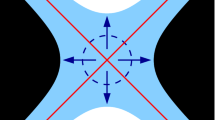Abstract
We prove the longtime existence for the mean curvature flow problem with a perpendicular Neumann boundary condition in a generalized Robertson–Walker (GRW) spacetime that obeys the null convergence condition. In addition, we prove that the metric of such a solution is conformal to the one of the leaf of the GRW in asymptotic time. Furthermore, if the initial hypersurface is mean convex, then the evolving hypersurfaces remain mean convex during the flow.
Similar content being viewed by others
References
Alías, L., Mastrolia, P., Rigoli, M.: Maximum Principles and Geometric Applications. Springer Monographs in Mathematics. Springer, Cham (2016)
Alías, L., Romero, A., Sánchez, M.: Uniqueness of complete spacelike hypersurfaces of constant mean curvature in Generalized Robertson Walker spacetimes. Tôhoku Math. J. 27, 71–84 (1995)
Alías, L., Romero, A., Sánchez, M.: Spacelike hypersurfaces of constant mean curvature and Calabi–Berstein type problems. Tôhoku Math. J. 30, 655–661 (1997)
Bellettini, G.: Lecture notes on mean curvature flow: Barriers and singular perturbations. Bull (New Ser) Am. Math. Soc. 54, 529–532 (2016)
Barros, A., Brasil, A., Caminha, A.: Stability of spacelike hypersurfaces in foliated spacetimes. Differ. Geom. Appl. 26, 357–365 (2008)
Chow, B., Knopf, D.: The Ricci flow: an introduction. Mathematical Surveys and Monographs, American Mathematical Society, vol. 110 (2004)
Ecker, K.: On the mean curvature flow of spacelike hypersurfaces in asymptotically flat spacetimes. J. Aust. Math. Soc. 55, 41–59 (1993)
Ecker, K.: Interior estimates and longtime solutions for mean curvature flow of noncompact spacelike hypersurfaces in Minkowski space. J. Differ. Geom. 45, 481–498 (1997)
Ecker, K., Huisken, G.: Parabolic methods for the construction of spacelike slices of prescribed mean curvature in cosmological spacetimes. Commun. Math. Phys. 135, 595–613 (1991)
Gilbarg, D., Trudinger, N.S.: Elliptic Partial Differential Equations of Second Order. Springer, Berlin (2001)
Han, Q.: Flow by Mean Curvature of Convex Surfaces into Spheres A Basic Course in Partial Differential Equations. American Mathematical Society, Providence (2011)
Huisken, G.: Flow by mean curvature of convex surfaces into spheres. J. Differ. Geom. 20, 237–266 (1984)
Lambert, B.: The perpendicular Neumann problem for mean curvature flow with a time like cone boundary condition. Trans. Am. Math. Soc. 7, 3373–3388 (2014)
Lieberman, G.: Second Order Parabolic Differential Equations. World Scientific Publishing, River Edge, NJ (1996)
Misner, C.W., Thorne, K.S., Wheeler, J.A.: Gravitation. W. H. Freeman and Co., New York (1973)
Montiel, S.: Uniqueness of spacelike hypersurfaces of constant mean curvature in oliated spacetimes. Proc. Am. Math. Soc. 3, 529–533 (1999)
O’Neill, B.: Semi-Riemannian Geometry with Applications to Relativity. Academic Press, London (1983)
Author information
Authors and Affiliations
Corresponding author
Additional information
Publisher's Note
Springer Nature remains neutral with regard to jurisdictional claims in published maps and institutional affiliations.
6 Appendix: A Simons’ type identity
6 Appendix: A Simons’ type identity
proof of Proposition 4.10
Let \({\overline{R}}\) and R be the Riemann tensors of N and \(\Sigma _t\) defined by:
for all \(X, Y, Z\in TN\) and
for all \(U, V, W\in T\Sigma _t\).
Set the coordinate vector fields \(\{\partial _i\}_{i=1}^{n+1}\) in N. In what follows we use Codazzi’s equation
being L the (0, 3)-tensor in the hypersurface \(\Sigma _t\) given by
We also need the (Riemannian) Ricci commutation formula
Using (61) and (63) one obtains
Now we should take in account the Gauss equation
Therefore
Taking traces we have
However
This implies the following general formula
Hence,
On the other hand
Therefore
We conclude that
Therefore
where \(T_{ij}=g^{k\ell }(\nabla _i L_{k\ell j}+\nabla _k L_{\ell ij}) a^{ij}.\) \(\square\)
Rights and permissions
Springer Nature or its licensor holds exclusive rights to this article under a publishing agreement with the author(s) or other rightsholder(s); author self-archiving of the accepted manuscript version of this article is solely governed by the terms of such publishing agreement and applicable law.
About this article
Cite this article
de Lira, J.H.S., Roing, F. Mean curvature flow of graphs in generalized Robertson–Walker spacetimes with perpendicular Neumann boundary condition. Annali di Matematica 202, 939–966 (2023). https://doi.org/10.1007/s10231-022-01266-y
Received:
Accepted:
Published:
Issue Date:
DOI: https://doi.org/10.1007/s10231-022-01266-y



